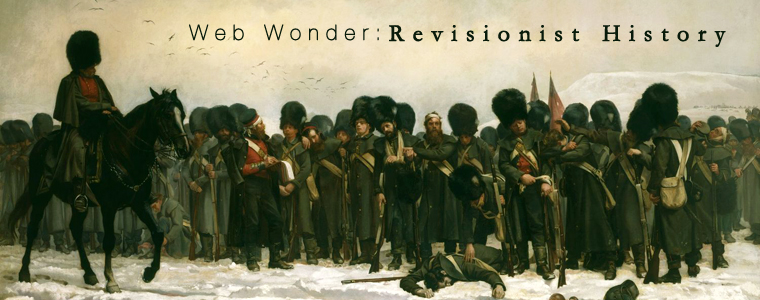Weaponized Curiosity
by Andrew Collins
When I queued up Malcolm Gladwell’s Revisionist History podcast last summer, I expected the show would be a hit. We’ve given his books the RedFence stamp of approval, and it seemed the versatile journalist-turned-pop-sociologist would have no trouble donning a few more hats as historian and podcaster.
To no surprise, but much delight, I was right. At a moment when the podcasting medium is enjoying a renaissance to the point of supersaturation, Revisionist History is a worthy addition to the medium.
The year is 1874, and a painting titled Roll Call has just taken the British Royal Academy summer exhibition by storm. The piece has a prime placement in the exhibition’s prestigious Gallery Two, and it seems all of London is flocking to see it.
The artist? A largely unknown 26-year-old woman named Elizabeth Thompson. Five years later she was nominated for membership in the Royal Academy, but she fell short of becoming the first woman accepted into the academy by just two votes. Despite subsequent nominations, she would never get in. Institutional rules (and cultural biases) against women, Gladwell speculates, sealed her exclusion. Though she continued to paint, Thompson faded into obscurity after marrying in British Army officer. It turns out, Gladwell says, the glass ceiling has a knack for solidifying even after it’s broken.
Gladwell sees this as “tokenism” – the tendency to accept a member of an excluded group to prove one’s “open-mindedness,” only to subsequently resume existing prejudices. And he immediately turns its application to a number of more recent political anecdotes, including the recent presidential elections in the United States.
[Editor’s Note: This political bent in the podcast is something of a departure from Gladwell’s previous works, which tended to be more scrupulously apolitical. More often than not this series seems to have a definite sociopolitical axe to grind. If the show has a weakness, in our opinion, this definitely is it.]
For any listener familiar with his work, stories like this are instantly recognizable as classic Gladwell — narratives full of disparate, intriguing, and surprisingly-connected ideas. Indeed, more than a decade after his breakthrough book The Tipping Point first hit the shelves, Revisionist History shows that the intrepid author isn’t close to running out of ideas. He spends each episode making his signature observations about the counterintuitive facets of human nature, asking probing questions that don’t occur to most people, and trying to provide one or two solid insights to make our society a better place.
For those who haven’t read Gladwell, Revisionist History might be a good place to start. It offers a Gladwell-lite, of sorts, bringing in a variety of voices to tell each story in fashion similar to This American Life. (For those who had to look up This American Life, Revisionist History also offers an excellent gateway to the podcasting medium.) Each of its ten episodes clock in at well under an hour. As the host, Gladwell speaks with a delightful journalistic vigor. His interest in how the world works is infectious, and he makes his ideas easy to understand without being overbearing or simplistic.
The show does move into new territory, a few episodes in, when Gladwell mounts one of his few hobby horses: endowments to Ivy League universities and other top schools like Stanford. He devotes three episodes in the middle of the show to a miniseries exploring what he sees as ongoing “inequality of opportunity” plaguing the American education system. In perhaps the most poignant moment on the show, he attacks what he sees as misguided philanthropy. His crusading goes back to a Twitter outburst in 2015 when Gladwell called out Wall Street billionaire John Paulson for donating $400 million to Harvard’s already-massive $36.4 billion endowment.
“It came down to helping the poor or giving the world’s richest university $400 mil it doesn’t need,” Gladwell tweeted. “Wise choice John!”
The middle episodes of the Revisionist History find Gladwell bearing down on this argument. He reams outgoing Stanford University president John Hennessy for his willingness to blithely accept a hypothetical gift of $10 billion rather than agreeing the money could be put to better use in, say, the University of California system, which educates a far greater number of students than Stanford. As a point of contrast, he takes us back to the example of Hank Rowan, a successful engineer and philanthropist who gave $100 million to a small state college in New Jersey rather than his alma mater, MIT. He was right to do so, Gladwell argues, because such a donation would do more to improve society at a university that really needed the money and could educate a broader, less-privileged group of students.
Agree with his case or not, it’s a definite pushback against any self-congratulatory, elitist tendencies in Gladwell’s New Yorker-reading audience, and it raises an important question for would-be donors to any organization or cause. Acts of philanthropy in America sometimes may be praised across the board – from supporting the animal shelter down the street to funding education through seven-figure university endowments. Perhaps they ought to ask, first, whether the money is being spent in the best way possible.
There’s an old proverb that says, “The wise man scales the city of the mighty and brings down the stronghold in which he trusts.” By this account, Gladwell strives to be a wise man. Wielding the humble power of curiosity, he challenges the modern temptation to make strongholds of progress, opportunity, and philanthropy, reminding us afresh not to be too quick to pat ourselves on the back.








